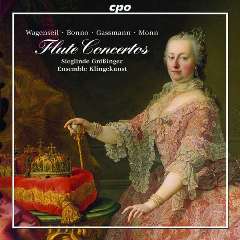Flötenkonzerte aus Wien (Flute Concertos from Vienna) [2017]
Flötenkonzerte aus Wien (Flute Concertos from Vienna) [2017]

Georg Christoph Wagenseil (1715-1777) Konzert für Querflöte, 2 Violinen und Basso continuo G-Dur 1 1. Allegro con spirito 2 2. Andante 3 3. Allegro Giuseppe Bonno (1711-1788) Konzert für Querflöte, 2 Violinen, Viola und Basso continuo G-Dur 4 1. Allegro 5 2. Adagio 6 3. Allegro Florian Leopold Gassmann (1729-1774) Konzert für Flöte, 2 Violinen, Viola und Basso continuo c-moll 7 1. Allegro 8 2. Adagio non tanto 9 3. Allegro di molto Matthias Georg Monn (1717-1750) Konzert für Cembalo, Querflöte, Violine und Basso continuo B-Dur 10 1. Allegro 11 2. Larghetto 12 3. Allegro Georg Christoph Wagenseil (1715-1777) Konzert für Querflöte, 2 Violinen, Viola und Basso continuo D-Dur 13 1. Vivace 14 2. Largo 15 3. Allegro Ensemble Klingekunst Sieglinde Größinger - flute & direction
Our first collaborative project with Klingekunst and the ensemble’s soloist and leader Sieglinde Größinger presents CD premiere recordings of the earliest Viennese flute concertos, which date from the reign of Empress Maria Theresa. The selected concertos by Georg Christoph Wagenseil, Giuseppe Bonno, Florian Leopold Gassmann, and Matthias Georg Monn, heard here on historical instruments, represent a significant contribution to the artistic recovery of the forgotten Viennese music culture of this epoch, a field that is only beginning to be researched. When Emperor Carl VI died in 1740, his successor Maria Theresa inherited a state budget burdened by heavy deficits. Forced to adopt economy measures, the new empress suspended the operation of the court orchestra and then offered its services to interested parties. However, the artistically marginalized musicians did not accept defeat when these unexpected developments put them in an existentially precarious position. No longer obliged to serve and obey a court aesthetic, they delighted in experimentation with new styles and forms of expression. The revolutionary character of these exciting times very much may be viewed as preparation for the Viennese classical period. Moreover, the flute now became a solo instrument for use in the orchestra and concert performances. Until about 1740 it was only rarely employed and then merely for additional tone color, but now it first enjoyed its share of spotlight. ---jpc.de
Topped and tailed by concertos by Wagenseil, this survey of the mid-18th-century flute concerto in Vienna also features works by Monn, Gaßmann and Bonno. Four of them are scored for flute with (here single) strings and continuo. Broadly speaking, they are rococo in style, not really managing to escape Baroque ritornello form, with solo episodes accompanied by upper strings or continuo. The odd man out in the recital is the Monn piece which is for concertato harpsichord, flute, violin and bass; it really is an original sounding composition, with the keyboard sometimes duetting with the flute, sometimes the true soloist while the flute and violin provide a duetting background. The presence of lute as a continuo instrument prevents any direct comparison with C. P. E. Bach’s quartets. It is a pleasant piece, though. In fact, the whole disc is enjoyable, and Größinger provides some neat cadenzas in the flute concertos. I suspect this is a line-up from whom we shall hear more. ---Brian Clark, earlymusicreview.com
download (mp3 @320 kbs):








